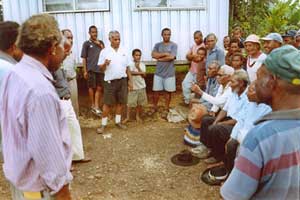 |
It took 41 years for the fastest developing 20 countries in the 20th century to achieve basic transformations in the rule of law. However, the World Development Report 2011 suggests that fragile countries cannot afford to wait that long. Instead, in managing disputes, it is imperative for governments and the international community to support arrangements that fit each country context, take into account capacity constraints in government and the local level, and respond to the needs of users. Justice reform should be measured accordingly from a functional perspective—based on the needs of users—rather than abstract modeling of institutions on western approaches.
The World Bank’s Justice for the Poor program recently sponsored a workshop in Solomon Islands to explore the role of ‘hybrid courts’ in supporting equitable dispute resolution. The term ‘hybrid courts’ is used to describe a variety of state initiatives that seek to formalize and support community justice systems within the state justice system. I will be blogging, in three parts, on whether hybrid courts might be effective in promoting equitable dispute resolution. Building on what participants from the Solomon Islands, Vanuatu, Papua New Guinea, Philippines, Sierra Leone, Nigeria and South Africa said about their hybrid courts, I will start with a short history of hybrid courts.
 |
| Lowa Village Court in PNG. Photo by J4P Consultant Michael Goddard |
From the outset, it’s important to recognize that many of today’s hybrid courts emerged during the colonial period. Typically, colonial powers introduced Western law for the foreign population, while accepting community forms of dispute resolution to varying degrees. This acceptance of community dispute resolution often involved elements of formalization, transformation and control by the state, including the incorporation of local decision makers into the government through hybrid courts.
In some cases (e.g., the Chiefs Courts of South Sudan), these new structures and authorities became effectively embedded in society and as a permanent feature of the judicial system through today. In others (e.g., customary courts of Liberia), they have had quite a mixed record of accountability both to the community and to the state, and have been the subject of contention.
Postcolonial states subsequently faced similar challenges as their colonial predecessors: limited geographical reach of state institutions, Western-modeled institutions often divorced from community structures and expectations, and resource constraints in the justice sector. Many of these new states turned to hybrid courts as a middle ground for supporting community decision-making while simultaneously expanding the authority and reach of the state.
Papua New Guinea, for example, included local decision-makers in the state justice system through Village Court magistrates. Today across Papua New Guinea there are more than 1,500 Village Courts hearing community problems through mediation and adjudication with supervision from the state. Likewise, the governments of Solomon Islands and Vanuatu established hybrid systems prior to, or immediately following, independence. In Solomon Islands, the number of these hybrid courts has steadily decreased since independence and in Vanuatu the courts remain today, but do not seem to be used to their full potential.
In my next entry, which I will post next week, I will talk about what makes hybrid courts effective in particular contexts. Why is it that hybrid courts appear to have succeeded in Papua New Guinea, for example, while they have fallen out of favor in other areas?


Join the Conversation